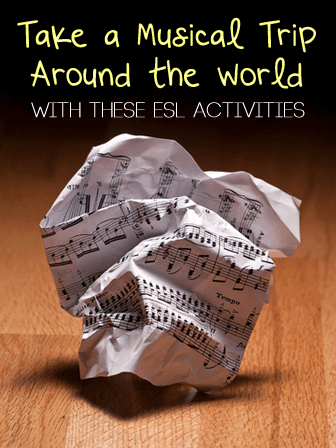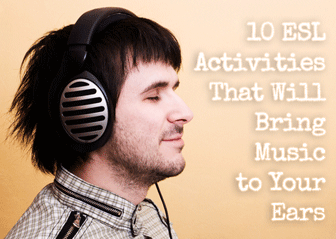Take a Musical Trip Around the World With These ESL Activities


Music is a chance for individuals to understand one another more and respect the values that others hold, so whistle while you work as your class entertains these music themed lessons.
Start your class with a discussion. What type of music do you listen to? Have each student share either with the entire class or with a small group. Each person should explain his answer as well. What groups do you like best? How did you first get interested in this type of music? What is it about this type of music that is appealing? If possible, allow each student to share a bit of his or her favorite music with the class. YouTube is a good resource for finding music on line if you have internet access in your classroom. Otherwise, ask your students to share from a portable music device.
A discussion of favorite music will naturally lead into the topic of genre. Explain to your students what the word genre means, and then as a class brainstorm a list of musical genres. You may want to print this extensive list of genres available from Wikipedia (or from here) and give it to your students. How many genres are they familiar with? Which have they never heard of? Which have you never heard of? Set small groups of students to do a little research either in class or for homework, and ask each group to give a presentation on a musical genre that is unfamiliar to them. Their presentations should include a description of the genre as well as an example from that genre if possible.
To take a more whimsical approach to music, give your students a list of the most popular music titles from a previous era. You may want to use a decade like the 1960’s, 1970’s or 1980's. If your students are all the same age, try getting a list of the top 100 songs from the year of their birth. Then have your students read the titles of these popular songs and then share their reactions. Do they have any comments on the titles of the songs? Do they seem strange or silly or just fine? What is most striking about them? Do they think songs with these titles could be popular today?
After looking at a list of these titles and playing some excerpts for your students if possible, ask your class to discuss how popular music has changed over time. What qualities did successful songs and musical groups possess in the past? How have those qualities changed for bands today? You may want to have your class create a Venn diagram in which they list the qualities of popular songs of the past and those of popular songs today. Then have your students write a paragraph in which they affirm or reject how popular music has changed.
If you have the hardware for it, you can download the free application “Top 100 Hits” which lists the top 100 songs from many countries around the world. You can also listen to samples of those songs with the app. Let your class explore this popular music, and then ask them to share their opinions on the songs. Do they notice any changes from one country’s popular music to another’s? What do they like about the music from other countries? Are there any consistencies across cultures? Are there any songs which show up on more than one list? If you desire, allow your students to share some of their favorite music from their home countries.
If you want to give your students a challenge, ask them to translate a favorite non-English song into English lyrics. Duplicate the lyrics and then share them with your class. Does the idea and message translate when its language changes? What cultural elements can be found in the songs?
Do any of your students play an instrument? Some countries have traditional instruments for traditional music. If any of your students plays one of these culture centered instruments, invite him or her to share a song with the class. Have each student who performs explain how to play the instrument, and then allow the rest of the class to ask questions about the instrument or the music that their classmate played. If you do not have any of this type of talent in your class, ask your school’s music teacher (if you have one) whether he knows of anyone who might be able to come to class and share some live music with your students.
If you are looking to bring a little creativity to the musical classroom, challenge each of your students to create his or her own original instrument. This can be done either on paper with a drawing or in three dimensions by creating working models. Have each student describe how it was made and give instructions how to play it in a class presentation. You can then have the class vote on awards for the most original, the most beautiful sounding and the strangest overall instrument.
Your students may or may not have heard of the Blue Man Group, so introduce them to this atypical musical group with one or two videos available on YouTube. Then play this interview about the group for your class. What makes the Blue Man Group different from other groups? How did the group come about? Ask your students to answer these questions. You may want to play the interview three or four times before asking for the answers.
The Blue Man Group is well known for using nontraditional materials to make music. Have each of your students write a personal letter to the group suggesting a material that they could use in their performance and what they could do with it.
Whether your students have musical talents of their own or simply admire the talents of others, they will enjoy your class when it is filled with these musical activities!